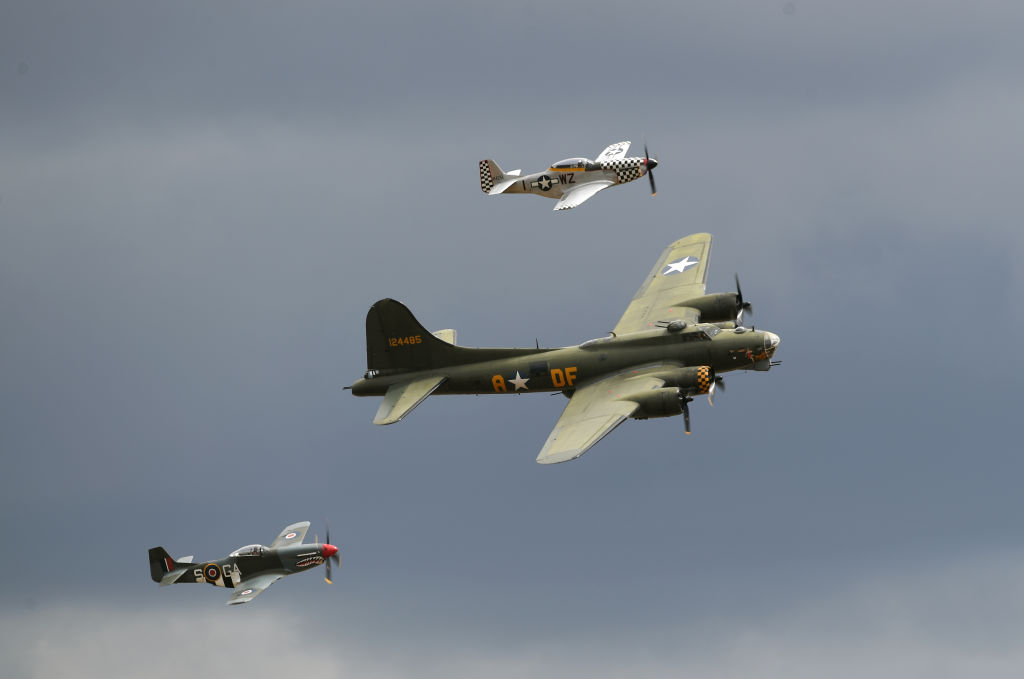Federal investigators are looking into what caused a vintage Boeing B-17 bomber to crash in Connecticut on Wednesday, killing seven people and injuring at least seven others.
The nearly 75-year-old World War II-era plane, nicknamed the “Flying Fortress” for its formidable size and armament, was operated by the Collings Foundation, a historic aircraft non-profit. It crashed just before 10 a.m. local time as it attempted to land at Bradley International Airport. Thirteen people were aboard the B-17, which struck a de-icing facility and maintenance facility upon landing. At least one person was inside the building struck by the airplane at the time of the crash, officials said.
“Our thoughts and prayers are with those who were on that flight and we will be forever grateful to the heroic efforts of the first responders at Bradley,” reads a statement posted to the Collings Foundation’s website. “The Collings Foundation flight team is fully cooperating with officials to determine the cause of the crash of the B-17 Flying Fortress and will comment further when details become known.”
The National Transportation Safety Board (NTSB)’s Jennifer Homendy told reporters that investigators will collect evidence from the crash scene over the next seven to 10 days and then release a preliminary report.
The Collings Foundation is one of several similar groups that operate vintage aircraft, often taking passengers for rides in exchange for donations. Thousands of B-17s were built during World War II to be used as bombers, primarily in Europe, says Dick Knapinski, a spokesperson for the Experimental Aircraft Association, which owns and operates its own Flying Fortress. While many B-17s were scrapped after the war, a number survived and were used for map-making, firefighting and more, Knapinski says. A handful of B-17s are now being used in air shows and national tours, many of which have been restored to look like they did in the 1940s.

But the Connecticut incident raises the question of whether it’s safe to fly aboard World War II airplanes, considering their age and other factors.
Ed Coleman, a professor at Embry-Riddle Aeronautical University, says the deadly incident is unlikely to deter aviation geeks, or “avgeeks,” from climbing aboard vintage planes — flights like those offered by the Collings Foundation give airplane enthusiasts a chance to see and ride aboard historical artifacts. And he argues that it’s still safe to fly in a plane like a B-17 despite their age. Hundreds of vintage airplanes, whether owned privately or by groups that take people on rides, are flown throughout the U.S, he says.
“To say we shouldn’t fly them would way overstep the bounds,” says Coleman. “These are flown safely every day.”
Still, an aircraft as old as the B-17 requires special attention compared to a modern plane, says Coleman. The B-17 uses four large radial engines, unlike the jet or turboprop engines typically found on modern aircraft of its size. Those engines, Coleman says, are more susceptible to certain issues than their modern counterparts.
“They can have an oil leak, a cylinder problem — there’s so many moving parts and pieces that any number of things could potentially cause a problem with it,” he says.
But Coleman adds that, under Federal Aviation Administration rules, vintage aircraft undergo more frequent maintenance and inspection. Meanwhile, groups that operate vintage airplanes like the B-17 typically rely on specialists who are intimately familiar with the special challenges involved with flying and fixing them.
And the Connecticut incident is something of a rarity. The last recorded B-17 crash came back in 2011, when an engine fire broke out on a Flying Fortress en route to Indianapolis. One of the seven people on board was injured, according to the NTSB’s accident database. The same B-17 that crashed on Wednesday was itself involved in a crash in 1987, when it was caught in crosswind while landing in Beaver Falls, Pennsylvania, the NTSB says.
Correction, Oct. 4
A caption in the original version of this story misstated the type of aircraft accompanying the B-17. They are P-51 Mustangs, not P-40 Warhawks.
More Must-Reads from TIME
- Cybersecurity Experts Are Sounding the Alarm on DOGE
- Meet the 2025 Women of the Year
- The Harsh Truth About Disability Inclusion
- Why Do More Young Adults Have Cancer?
- Colman Domingo Leads With Radical Love
- How to Get Better at Doing Things Alone
- Michelle Zauner Stares Down the Darkness
Write to Mahita Gajanan at mahita.gajanan@time.com